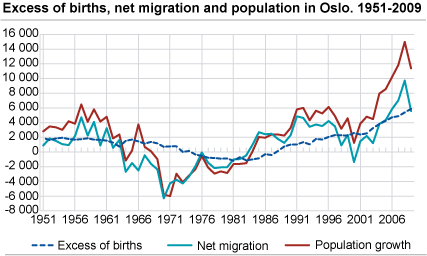Content
Published:
This is an archived release.
Population development since the 1950s
The historical overview of population changes in Norwegian municipalities from 1951 has been updated with population changes in 2009 and resident population as of 1 January 2010.
It has become easier to study population changes in individual municipalities by using the historical statistics series with annual figures on population, population growth, excess of births over deaths, net migration, births, deaths, in-migration and out-migration.
Various reasons for growth
Long time series with annual figures for each municipality provide a retrospective look at periods with changing conditions for growth and development, making development trends more distinct. Population trends are presented and population growth and decline can be studied, including breakdowns by excess of births over deaths and migration balance. The time series reveal whether a higher excess of births over deaths is due to more births or fewer deaths, and whether less favourable migration balances are due to a decline in in-migration or an increase in out-migration.
Growth in central parts of the country
Internal movements and immigrations mainly flow to the big cities and their surroundings, while the population in the remote municipalities decreases. There has been a population growth during the last decade in Oslo, with an increase of about 16 per cent, Stavanger 14 per cent and Trondheim 15 per cent. In Bergen, however, the population growth has been 12 per cent. The whole country had 8 per cent population growth in the last decade.
Since 1951, the population in the city of Oslo has increased by 35 per cent, but the population growth has fluctuated considerably over these years. The number of births fell considerably in the 1970s and early 1980s. This has changed, and there have never been so many children born in Oslo (in absolute numbers) as in recent years. The capital now experiences a solid excess of births. In the same period, the population in the whole country has increased by 48 per cent.
Internal movements flow from the north and west
A considerable number of municipalities in the north and northwest have, for several decades, been losing inhabitants to the rest of the country. Some of these municipalities experienced population growth due to the excess of births compensating for out-migration. However, when the number of births fell considerably in all parts of the country in the 1970s, the excess of births over deaths became too small to compensate for out-migration. In the 1980s, the number of births increased, but this was primarily in central municipalities.
The statistics is published with Population.
Contact
-
Statistics Norway's Information Centre
E-mail: informasjon@ssb.no
tel.: (+47) 21 09 46 42

